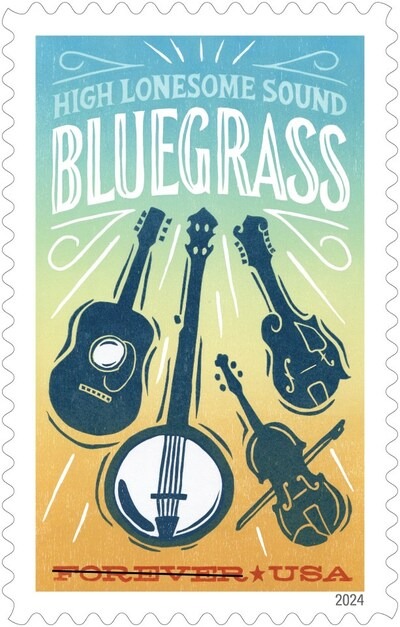The U.S. Postal Service today announced many of the stamps it will issue in 2024.
“As always, our stamp program features a broad array of subjects and designs. Stamps are miniature works of art and often tell a story that highlights our American culture, our people or an important point in our history,” said Lisa Bobb-Semple, acting Stamp Services director for USPS. “Stamps also allow us to show what’s important to us as we carefully select which stamp adorns our mailpieces. The 2024 stamps were designed to offer the American public a broad array of choices for those looking to collect stamps or send a special message.”
In March, they will put the spotlight on bluegrass music.
Born in the mid-20th century, bluegrass defies time, drawing inspiration from the past while also openly embracing innovation. At once rural and urban, emotional and highly technical, this singular American music style remains unconstrained by geography, attracting fans worldwide who all share the same passion for what they affectionately call the “high lonesome sound.”
Inspired by vintage bluegrass concert posters, the stamp art features four acoustic string instruments typical of bluegrass bands: guitar, five-string banjo, fiddle, and mandolin. Text at the top of the stamp reads “High Lonesome Sound,” the title of a 1963 documentary about Appalachian folk music and a familiar nickname for bluegrass.
The five-string banjo dominates the sound of bluegrass and, along with guitar, mandolin, and bass, sets the rhythmic foundation of this often fast-paced music. Fiddle, mandolin, banjo, and guitar evoke a range of melodic flavors and emotions in their solos and backup. Instrumental dexterity, combined with tight vocal harmonies and heartfelt, sometimes mournful lyrics, creates an electrifying and emotional experience for both performers and listeners.
Music historians generally agree that bluegrass as we know it originated with Bill Monroe (1911–1996), who drew on old-time fiddle and church music as well as gospel, blues, and jazz to fashion a style of music that was both brand-new and achingly familiar. By 1945, Monroe and his band, the Blue Grass Boys, had solidified the key components of bluegrass: refined vocal harmonies, driving tempos, and outstanding musicianship.
Once viewed as a type of country music, bluegrass—which musicologist Alan Lomax famously described as “folk music with overdrive”—emerged as its own distinct genre in the 1950s. Soon the music could be found just about everywhere, from college campuses and large urban areas to television shows and movies. Outdoor festivals became a mainstay of bluegrass in the 1970s, a period when the music took off in new directions as bands eagerly incorporated influences from rock and pop.
Today, although bluegrass enjoys relatively little radio exposure, the music continues to thrive. The nonprofit International Bluegrass Music Association was founded in 1985, a bluegrass category was added to the Grammy Awards in 1989, and the Bluegrass Music Hall of Fame was founded in Owensboro, Kentucky, in 1991. Billboard launched its bluegrass albums chart in 2002, two years after the wildly popular soundtrack to the film O Brother, Where Art Thou? introduced bluegrass to yet another generation of fans. Today, bluegrass festivals held around the world, like the Telluride Bluegrass Festival in Colorado and Bluegrass Live! in North Carolina, draw thousands of fans every year.
Art director Antonio Alcalá worked with designer and illustrator Heather Moulder to produce the stamp art.







